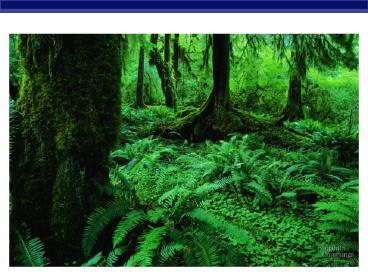AP - PowerPoint PPT Presentation
1 / 31
Title:
AP
Description:
Energy needs of life. All life needs a constant input of energy. Heterotrophs ... because they absorb light wavelengths in red & blue and reflect green back out ... – PowerPoint PPT presentation
Number of Views:75
Avg rating:3.0/5.0
Title: AP
1
(No Transcript)
2
Chapter 10. Photosynthesis Life from
Light
3
Energy needs of life
- All life needs a constant input of energy
- Heterotrophs
- get their energy from eating others
- consumers of other organisms
- consume organic molecules
- Autotrophs
- get their energy from self
- get their energy from sunlight
- use light energy to synthesize organic molecules
4
Energy needs of life
- Heterotrophs
- consumers
- animals
- fungi
- most bacteria
- Autotrophs
- producers
- plants
- photosynthetic bacteria(blue-green algae)
5
How are they connected?
Heterotrophs
making energy organic molecules from ingesting
organic molecules
Autotrophs
making energy organic molecules from light
energy
6
Energy cycle
Photosynthesis
Cellular Respiration
7
What does it mean to be a plant
- Need to
- collect light energy
- transform it into chemical energy
- store light energy
- in a stable form to be moved around the plant
also saved for a rainy day - need to get building block atoms from the
environment - C,H,O,N,P,S
- produce all organic molecules needed for growth
- carbohydrates, proteins, lipids, nucleic acids
8
Plant structure
- Obtaining raw materials
- sunlight
- leaves solar collectors
- CO2
- stomates gas exchange
- H2O
- uptake from roots
- nutrients
- uptake from roots
9
(No Transcript)
10
Stomates
11
Plant structure
- Chloroplasts
- double membrane
- stroma
- thylakoid sacs
- grana stacks
- Chlorophyll ETC in thylakoid membrane
- H gradient built up within thylakoid sac
12
Pigments of photosynthesis
Why does this structure make sense?
- chlorophyll accessory pigments
- photosystem
- embedded in thylakoid membrane
- structure ?? function
13
A Look at Light
- The spectrum of color
14
Light absorption spectra
- Photosynthesis performs work only with absorbed
wavelengths of light - chlorophyll a the dominant pigment absorbs
best in red blue wavelengths least in green - other pigments with different structures have
different absorption spectra
15
Chloroplasts
- Chloroplasts are green because they absorb light
wavelengths in red blue and reflect green back
out
structure ?? function
16
Photosystems
- Photosystems
- collections of chlorophyll molecules
- 2 photosystems in thylakoid membrane
- act as light-gathering antenna complex
- Photosystem II
- chlorophyll a
- P680 absorbs 680nm wavelength red light
- Photosystem I
- chlorophyll b
- P700 absorbs 700nm wavelength red light
17
Photosynthesis overview
- Light reactions
- convert solar energy to chemical energy
- ATP
- Calvin cycle
- uses chemical energy (NADPH ATP) to reduce
CO2 to build C6H12O6 (sugars)
18
Light reactions
- Similar to ETC in cellular respiration
- membrane-bound proteins in organelle
- electron acceptors
- NADPH
- proton (H) gradient across inner membrane
- Wheres the double membrane?
- ATP synthase enzyme
19
The ATP that Jack built
respiration
photosynthesis
sunlight
breakdown of C6H12O6
- moves the electrons
- runs the pump
- pumps the protons
- forms the gradient
- releases the free energy
- allows the Pi to attach to ADP
- forms the ATP
- that evolution built
20
ETC of Respiration
- Mitochondria transfer chemical energy from food
molecules into chemical energy of ATP - use electron carrier NADH
generate H2O
21
- Chloroplasts transform light energy into chemical
energy of ATP - use electron carrier NADPH
ETC of Photosynthesis
split H2O
22
ETC of Photosynthesis
23
ETC of Photosynthesis
24
ETC of Photosynthesis
25
ETC of Photosynthesis
- ETC produces from light energy
- ATP NADPH
- NADPH (stored energy) goes to Calvin cycle
- PS II absorbs light
- excited electron passes from chlorophyll to
primary electron acceptor - need to replace electron in chlorophyll
- enzyme extracts electrons from H2O supplies
them to chlorophyll - splits H2O
- O combines with another O to form O2
- O2 released to atmosphere
- and we breathe easier!
26
Experimental evidence
- Where did the O2 come from?
- radioactive tracer O18
Proved O2 came from H2O not CO2 plants split H2O
27
2 Photosystems
- Light reactions elevate electrons in 2 steps (PS
II PS I) - PS II generates energy as ATP
- PS I generates reducing power as NADPH
28
Cyclic photophosphorylation
- If PS I cant pass electron to NADP, it cycles
back to PS II makes more ATP, but no NADPH - coordinates light reactions to Calvin cycle
- Calvin cycle uses more ATP than NADPH
29
Photophosphorylation
cyclic photophosphorylation
noncyclic photophosphorylation
30
Photosynthesis summary
- Where did the energy come from?
- Where did the H2O come from?
- Where did the electrons come from?
- Where did the O2 come from?
- Where did the H come from?
- Where did the ATP come from?
- Where did the O2 go?
- What will the ATP be used for?
- What will the NADPH be used for?
stay tuned for the Calvin cycle
31
Any Questions??































